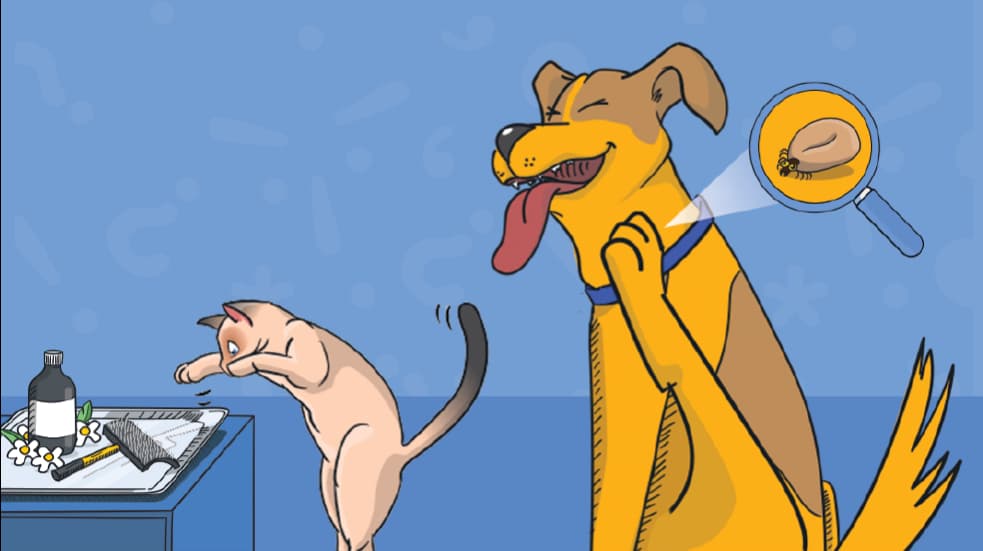

Using Bravecto for Dog & Cat Flea Treatments: Miracle Cure or Risky Business?
Anyone who owns a dog or cat knows- fleas and ticks are more than just a nuisance. In fact, they’re a tiny, not-so-dynamic duo that can cause major problems. But are the new veterinary treatments available today really the miracle solution to this issue? Or could they also pose a risk to your dog or cat? Animalia sets the record straight.

Writer Roi Kadosh
6 min read

Meet Bravecto, NexGard, and friends- in short, the Isoxazoline family
Aside from being a bit of a tongue twister, isoxazolines are a relatively newer class of medications that have been in veterinary use for almost a decade. You can recognize the drugs in this family by the suffix “laner” in the name of their active ingredient. Since they were introduced, these medications have truly revolutionized flea and tick treatments.
Out of all of them, Bravecto is probably the most well-known. It’s available in a chewable tablet or as a topical solution applied to the skin. Its effect lasts between 8 to 12 weeks (and not exactly three calendar months, contrary to popular belief). Other highly effective drugs in the same family include NexGard (the first in the family to receive FDA approval), Simparica, and Credelio. There is a big difference between them and Bravecto, though- their effectiveness is shorter, lasting only four weeks.
So how do these medications work?
The active ingredients in Bravecto and other drugs in the family are absorbed through either chewables or topical ampules, distributed to the subcutaneous blood vessels of the dog or cat. Then, when a flea or tick tries to take a blood meal, it also ingests the medication, which kills it. It has also been found that these drugs effectively kill a wide range of insects, mites, and other pests common in pets, including scabies, lice, ear mites, demodex, and even mosquitoes. On the one hand, these medications are extremely toxic to parasites, killing them almost immediately, while on the other, they’re not at all toxic to mammalian cells, making them both effective and safe.

Are they safe or dangerous for dogs and cats?
Have no fear, Animalia’s here- and we’ll break it all down for you. For years, the internet has been flooded with questions about these drugs, especially Bravecto and NexGard, the more established ones in the group. You can find online reports from owners about severe side effects and even death, all allegedly caused by these medications. There are even Facebook groups claiming that these drugs are killing dogs and cats. However, the truth is that these reports are not very reliable, and there are two main reasons why:
- Most of the reports are not supported by reliable medical documentation, which raises suspicion that they may be influenced by commercial interests. It is important to note that these are prescription drugs sold only in veterinary clinics- not on the open market. For this very reason, you should avoid purchasing them from non-veterinary, unregulated sources like brick-and-mortar stores or suspicious online outlets.
- We humans have a tendency to try to connect a specific cause to every event. It’s pretty natural, and it even has a name: cognitive bias. The problem is that it isn’t always the case. Conditions like gastric torsion (bloat) in dogs or heart incidents in cats do happen, and may sometimes tragically lead to sudden death. If, by coincidence, Bravecto was given on that same day or the day before, owners often tend to link the two. Why? Because we want to find reasons for things we don’t understand… The reality, though, is that millions of dogs and cats receive Bravecto, Simparica, and other similar medications every single day. Even if a very small number of them happen to fall ill or pass away suddenly without any other specific cause, it doesn’t mean the drug caused it.
These medications have indeed been approved by the Food and Drug Administration (FDA), which means they’ve been proven to be both effective and safe by a very stringent authority. All of them come with warnings about side effects, which are definitely observed occasionally: mostly temporary digestive disturbances and mild skin inflammations.
But there is one particular warning about these drugs that everyone should know: they are not recommended for pets with neurological problems, especially epilepsy or other seizure disorders. This warning is also endorsed by the FDA and is clearly noted in the medication inserts. Do note that while the drugs don’t cause seizures themselves, they do lower the seizure threshold- meaning those who are already prone to seizures are more likely to have them under the influence of the medication.
Bottom line? Most veterinarians will recommend these drugs for their combination of high efficacy and safety. Of course, they’re not a perfect solution, but anyone who remembers the tough years of dealing with fleas and ticks using older pesticides- which often didn’t work well and caused numerous side effects- will truly appreciate this new generation of medications.

Should you use these treatments in wintertime too?
Absolutely! Global warming is causing many pests to break out of their seasonal cycles, making them active all year round (as if global warming wasn’t enough trouble already…). Besides, in the hotter regions of the country, where there often isn’t a “real” winter, fleas tend to hang around nearly all year long. Ticks also thrive in many parts of the country year-round, making prevention crucial as these pests can transmit very dangerous bacteria and blood parasites to dogs, cats, and humans alike. Additionally, flea allergies and various skin mite infestations, such as scabies, demodex, and ear mites, can also be treated or prevented thanks to these drugs, and many of these parasites are active in the winter as well.
What if the dog or cat refuses to take the tablets?
People sometimes think the big advantage of drugs like Bravecto is that they come in tablet form. This actually isn’t true. The real advantage of this drug family lies in the active ingredients themselves, not in the form in which they’re given.
Some prefer tablets: they’re less messy, children can’t accidentally touch the medication, and some dogs and cats find it easier to receive their treatment this way. However, some of these medications also come as topical solutions, for those who prefer not to use tablets or for pets who refuse to swallow them. Just remember not to bathe your dog (or cat, though who would even try?) or let them swim for three days after applying it. In any case, current research shows that both methods are equally effective and safe.
It’s the pet parents’ responsibility to make sure their dogs and cats are cared for, in as many aspects as you can control. Protecting them from fleas, ticks, and other parasites is a good example. The problem is that you simply can’t control everything, and that’s where Animalia’s dog and cat insurance steps in. Our coverage will ensure there’s nothing you can’t handle, and no treatment or procedure you can’t afford.





We offer the most
comprehensive coverage
out there
car with a spare tire for life’s bumps.
Having Animalia is like a pimped-out
Rolls Royce with a swimming pool
in the trunk.



Get your pet insurance quote
Pet type
- Dog
- Cat





